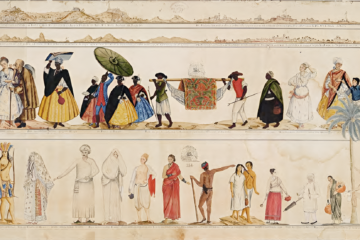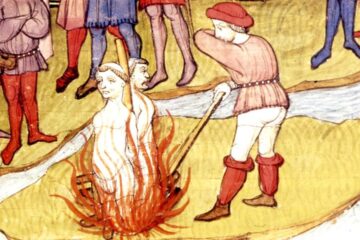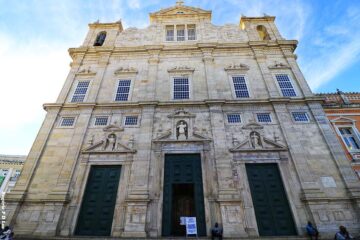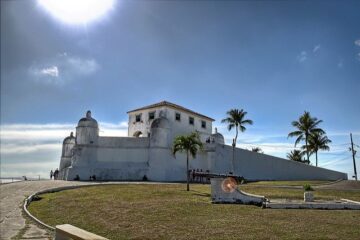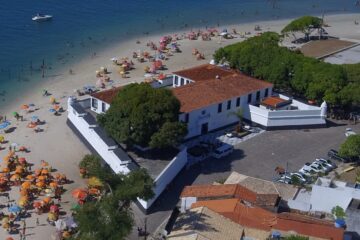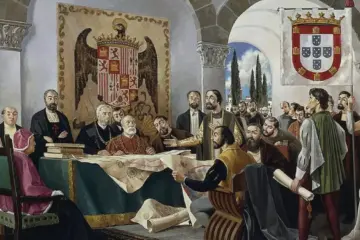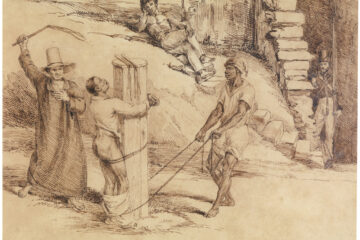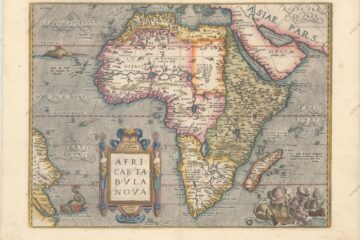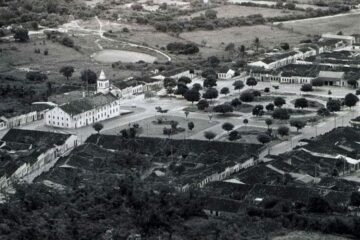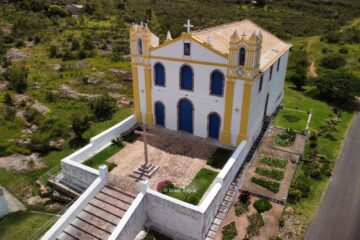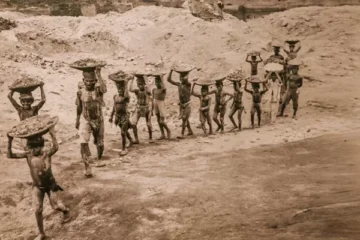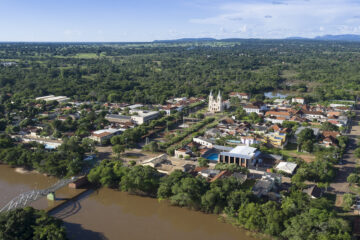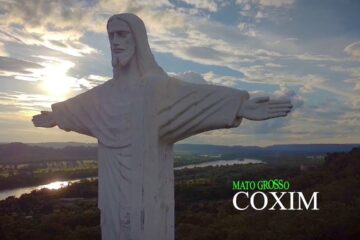Luiz Gonzaga: The legacy of the King of Baião in Brazilian music
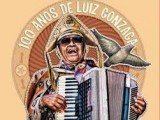
Luiz Gonzaga (1912-1989) was a renowned Brazilian musician, known as a accordionist, singer and composer.
He was given the title “King of the Baião” for his significant contribution to the valorisation of the northeastern rhythms, bringing the baião, xote and xaxado to the whole country.
The anthem of the northeast

The song “Asa Branca”, composed in collaboration with Humberto Teixeira and recorded by Luiz Gonzaga on 3 March 1947, has become a true anthem of the Northeast of Brazil.
The song, which describes the drought and forced migration of the people of the Northeast, is an example of the deep emotional and social appeal of his work.
Early years
Luiz Gonzaga was born in Fazenda Caiçara, in Exu, in the interior of Pernambuco, on 13 December 1912.
He was the son of Januário José dos Santos, known as “mestre Januário”, an 8-bass accordion player, and Ana Batista de Jesus.
The couple had eight children. From an early age, Luiz Gonzaga showed a talent for music, and at the age of 13 he bought his first accordion with borrowed money.
Escape and military career
In 1929, Luiz Gonzaga fled to the city of Crato, in Ceará, because the girl’s family had forbidden him to woo her.
The following year he moved to Fortaleza, where he joined the army. During the 1930 Revolution he travelled around the country.
In 1933, while serving in Minas Gerais, he failed an army music competition and became a cornet player. During this time he took accordion lessons from the soldier Domingos Ambrósio.
Rise in music
Luiz Gonzaga left the army after nine years without hearing from his family. He moved to Rio de Janeiro, where he began performing in bars, cabarets and fledgling programmes. In 1940, he took part in the Calouros Programme of Rádio Tupi and won first prize with the song “Vira e Mexe”.
As an accordionist in the duo Genésio Arruda e Januário, he was discovered by the record company RCA Victor, which encouraged him to record his first album. Success came quickly and several more records were released, but it wasn’t until 11 April 1945 that he recorded his first album as an accordionist and singer, with the song Dança Mariquinha.
Private life and partnerships
On 23 September his son Gonzaguinha was born, the fruit of his relationship with the singer Odaléia Guedes. In the same year he met his partner Humberto Teixeira.
After 16 years, Luiz returned to his homeland. In Recife he appeared on various radio programmes and in 1947 he recorded “Asa Branca“, in partnership with Humberto Teixeira.
In 1948 he married the singer Helena Cavalcanti and in 1949 he moved with his family to Rio de Janeiro. His partnerships with Humberto Teixeira and Zédantas resulted in many hit songs, and Gonzaga and his group performed in various parts of the country.
Recognition and legacy
In 1980, Luiz Gonzaga had the honour of singing for Pope Paul II in Fortaleza and also performed in Paris at the invitation of Amazonian singer Nazaré Pereira. He received the Gold Nipper Award and two gold discs for the album “Sanfoneiro Macho”.
In 1988 he separated from Helena and started a relationship with Edelzita Rabelo. Luiz Gonzaga was admitted to the Santa Joana Hospital in Recife on 21 June 1989 and died on 2 August..
The centenary of his birth was celebrated in 2012 with the release of the film “De Pai Para Filho” (From Father to Son), which tells the story of the relationship between Gonzaga and Gonzaguinha. The artist has been honoured throughout the country, including tributes at festivals and exhibitions celebrating his contribution to Brazilian music.
How Luiz Gonzaga’s songs have influenced other musical genres in Brazil
Luiz Gonzaga’s songs have had a significant impact on various musical genres in Brazil, shaping popular music and influencing generations of artists. Here are some of the ways in which his work has influenced other styles:
- Baião and Brazilian Popular Music (MPB): Luiz Gonzaga was instrumental in spreading baião, a genre that combines African and Portuguese elements, and his popularisation helped to integrate it into MPB. Artists such as Gilberto Gil and Caetano Veloso incorporated northeastern rhythms into their music, showing Gonzaga’s direct influence.
- Forró: Gonzaga is considered one of the main people responsible for bringing forró to a wider audience. His compositions and style of playing the accordion laid the foundations for many other forrozeiros, such as Dominguinhos and Fagner, who continued the tradition and innovated within the genre.
- Sertanejo: The sertanejo movement, which came to prominence in the 1980s and 1990s, was also influenced by the northeastern rhythms popularised by Gonzaga. The fusion of elements of baião and xote with sertanejo music is evident in several contemporary hits.
- Influence on composers and performers: Many Brazilian composers and performers cite Luiz Gonzaga as an important reference. Artists such as Elba Ramalho, Zezé Di Camargo & Luciano and Alceu Valença incorporate his aesthetic and sonic elements into their work, demonstrating his lasting influence.
- Regional rhythms and themes: Gonzaga’s songs deal with themes of everyday life in the Northeast, such as drought, love and the struggle of the people. This connection to cultural roots influenced other genres to explore social and regional themes, enriching Brazilian music as a whole.
- Fusion of genres: Luiz Gonzaga was a pioneer in the fusion of different musical styles, combining elements of popular music, folk music and even jazz in some of his compositions. This innovative approach encouraged other artists to experiment and mix genres, resulting in new sounds.
Conclusion
In conclusion, Luiz Gonzaga not only popularised baião and other northeastern rhythms, but also left a legacy that spans several strands of Brazilian music, influencing artists and genres in profound and lasting ways. His work continues to resonate and inspire new talent, reaffirming his importance in Brazil’s musical culture.
Luiz Gonzaga’s hits
- White Wing
- Sertão Moonlight
- Ceará’s supplication
- The Caruaru Fair
- On my mountain
- The sad farewell
- Take Preto
- Look at the sky
- Rock me
- Paraíba
- Pau de Arara
- Cintura Fina
- I can’t wait
- Riacho do Navio
- Xote das Meninas
- There’s nothing like this in Ceará
- In a plastered room
- Respect for Januário
- Russian Pagoda
- Último Pau de Arara
- The bellows snore
- Zé Matuto
- Seventeen and seven hundred
- Mariquinha Dance
- Baião de Dois
- The ABC of Sertão
Luiz Gonzaga remains an icon of Brazilian popular music, leaving a legacy that still resonates in the country’s culture.
Publicações Relacionadas
The Evolution of Forró: A Musical Journey
João Gilberto: The Father of Bossa Nova
Musical Style and History of Samba de Roda
Gilberto Gil - Biography, history and musical legacy
Alcione: The Journey of a Music Icon
Elba Ramalho: A Journey Through Music History
Biography of Dominguinhos, the accomplished accordionist
Gal Costa: Biography of a Musical Icon
Biography of Os Novos Baianos
History of Bossa Nova - When Bossa Nova conquered the world
Olodum with Michael Jackson in Salvador de Bahia
Biography of Maria Bethania
Biography of Morais Moreira
Biography of Simone Bittencourt
Biography of Ivete Sangalo
Forró Pé-de-Serrra: The Heart of Brazilian Music
Biography of Dorival Caymmi
Carlinhos Brown: Biography of a Percussion Legend
This post is also on:
![]() Português
Português ![]() English
English ![]() Deutsch
Deutsch ![]() Español
Español ![]() Français
Français




